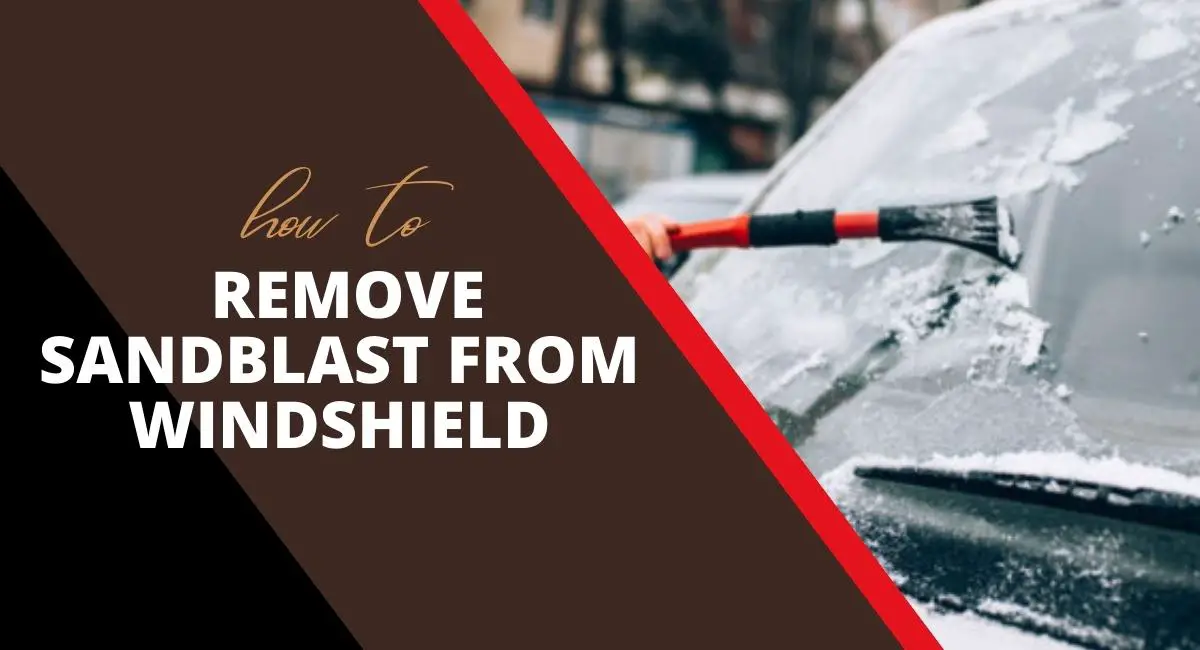Have you ever encountered those frustrating sandblast marks on your windshield or glass? Not only do they obstruct your vision while driving, but they also diminish the overall aesthetic appeal of your vehicle.
A sandblasted windshield occurs due to the damage caused by the continuous impact of sand particles on the auto glass. While individual sand particles may not cause immediate harm upon impact, their persistent collision over time can result in tiny holes obstructing your view of the road.
Though some people feel it is easier and cheaper to replace the windshield rather than remove the sandblast, what is the ultimate solution on how to remove sandblast from the windshield? In this comprehensive guide, we will walk you through the step-by-step process of removing sandblasts from windshields, exploring various effective methods, discussing fixing sandblasted windshields, and highlighting preventive measures to keep your windshield pristine.
Assessing the Damage
Before diving into the removal process, assessing the severity of sandblast damage on your windshield or glass is crucial. Look at the marks and determine if they are minor surface abrasions or caused deeper cracks or chips. If the damage is superficial, you can proceed with the removal methods outlined below. If you notice significant cracks or chips, it is advisable to consult a professional for windshield repair or replacement.
Assessing the damage of sandblasted windshields is an essential first step in deciding the right course of action for repair. Here’s how you can do it:
Visual Inspection: Start with a visual inspection of the windshield. A sandblasted windshield typically has a dull or hazy appearance as opposed to the clear and glossy look of undamaged glass. Look closely for numerous tiny scratches or pits on the glass surface.
Touch Test: Run your hand gently over the windshield’s surface. If it feels rough or uneven to the touch, there’s a good chance it has been sandblasted.
Light Test: Light scattering can be an excellent indicator of a sandblasted windshield. At night, turn on your vehicle’s interior light or use a flashlight to illuminate the windscreen from the inside. A sandblasted windshield occurs if the glass appears to have a cloudy or frosty surface from the outside.
Visibility Assessment: Another critical factor in assessing the damage is your visibility when driving. If oncoming headlights seem excessively bright or dazzling or your overall visibility has diminished, the windshield may have suffered sandblasting damage.
If the damage is minimal, you can address it with a DIY approach using a glass polishing kit. For more extensive damage, however, professional repair, or you may even require a full windshield replacement.
Remember, it’s crucial to address sandblasting damage as soon as possible, not just for aesthetic reasons but, more importantly, for safe driving.
What Causes Sandblasting on Auto Glass?
The primary factor behind sandblasted windshields is driving too closely to the vehicle in front. When you don’t maintain an adequate following distance, the tires of the car ahead fling sand, small stones, and various road fragments directly onto your windshield. The closer you tailgate, the greater the impact and potential damage to your windshield.
Here are the main factors that cause sandblasting on the auto glass when tailgating:
Dust and Sand Particles: Driving in areas with high dust or sand concentration, such as deserts or beaches, can cause sandblasting. The wind can carry these tiny particles and blast them against the windshield, causing microscopic scratches and pits.
Road Debris: Sandblasting can also occur when small pieces of gravel or other road debris are thrown into the air by vehicles traveling ahead of you, especially at high highway speeds. These particles can hit your windshield and cause damage.
Construction Sites: These are notorious for causing sandblasted windshields, as they often have loose dirt, sand, and gravel that can easily be carried by the wind or kicked up by passing vehicles.
Weather Conditions: Certain weather conditions, such as wind or sand storms, can cause a higher concentration of airborne particles. Driving in these conditions can significantly increase the likelihood of your windshield becoming sandblasted.
Poorly Maintained Roads: Roads in poor condition with a lot of loose gravel or dirt can also be a major contributor to windshield sandblasting.
While it’s not always possible to avoid these conditions, regular cleaning and maintenance, protective windshield coatings, and being mindful of following distances on the road can help reduce the risk of sandblasting on your auto glass.

How to Remove Sandblasting from Glass: Preparing for the Removal Process
Before tackling the sandblast marks, it’s essential to gather the necessary supplies and find a suitable location for the cleaning process. You will need:
A high-quality glass cleaner or a soft cloth or sponge
- Sandpaper
- Microfiber cloths
- A glass polishing kit, which includes a polishing pad, glass polishing compound, and, ideally, a rotary buffer tool
- Vinegar,
- Water
- Toothpaste
- Gloves
- Eye protection.
Find a shaded area or a garage to work in, ensuring no direct sunlight or dust could interfere with the process. Safety should always be a priority, so remember to wear protective gloves and safety glasses. Ensure your work area is well-ventilated to avoid inhaling any harmful fumes from the cleaning solutions.
Removing Sandblast from Windshield Using a Glass Polishing Compound
The windshield has several layers. It has the outboard layer, the polyvinyl butyral (PVB) inner layer, and the inboard layer. The PVB layer is heat-resistant and contains plastic. Now, the following steps will help remove the sandblast:
- Clean the windshield using the window cleaner and the rotary buffer tool to remove the contaminants.
- Then, apply the water spot remover on the affected windshield areas.
- Now, set up the rotary buffer tool with the right polishing pad since it has different coarseness. Ensure the auto scrub system or the rotary buffer tool has the right settings. For instance, set the right temperature to avoid hazing on the outside layer.
- Check the windshield to identify whether the glass is clear. If not, repeat the process with a more aggressive water spot remover or the glass polishing compound, especially the heavy-duty type. And increase the pressure to remove the contaminants.
DIY Methods on How to Fix Sandblasted Windshield
A thorough cleaning is the first step to fixing a sandblasted windshield. Use a quality glass cleaner and microfiber cloth to wipe the windshield, removing all surface dirt and debris. A pristine surface is essential to avoid further scratches during the polishing process.
Method 1: Using Vinegar and Water
- Begin by creating a solution of equal parts vinegar and water.
- Apply the key to the sandblasted area and let it sit for a few minutes.
- Gently scrub the area using a soft cloth or sponge, applying light pressure to avoid scratching the glass.
- Rinse the windshield with clean water and dry it thoroughly using a microfiber cloth.
Method 2: Using Toothpaste
- Apply a small amount of toothpaste directly to the sandblasted area.
- Rub the toothpaste in circular motions using a clean cloth, applying gentle pressure.
- Continue rubbing until the sandblast marks start to fade.
- Wipe off the toothpaste residue with a damp cloth and dry the windshield using a microfiber cloth.
Method 3: Using Glass Polishing Compound
- Apply a small amount of glass polishing compound to a clean cloth.
- Rub the combination onto the sandblasted area in circular motions, applying light to moderate pressure.
- Continue buffing until the sandblast marks become less visible.
- Wipe any remaining residue with a clean, damp cloth, then dry the windshield thoroughly.
Fixing Sandblasted Windshield
In cases where the sandblast damage is extensive or has caused cracks and chips, it is wise to consult a professional for windshield repair or replacement. They have the expertise and tools to assess the damage accurately and provide the most suitable solution. While repair may be a cost-effective option for minor cracks and chips, extensive damage may necessitate windshield replacement for optimal safety and visibility.
Preventive Measures
Prevention is always better than cure when maintaining a windshield. Regularly clean your windshield and use high-quality glass cleaners to remove dirt and debris that could cause sandblast marks. In areas prone to sandblasting, consider using windshield protectors or covers to shield your glass from flying debris.
Important Read: Turbocharge Your Ride—Making Your Dodge Dart Faster
Conclusion
Using household items and a little effort, you can restore your windshield and enhance your driving experience. If the damage is extensive, seek professional assistance. Remember to take preventive measures to protect your windshield from future sandblasting damage.
